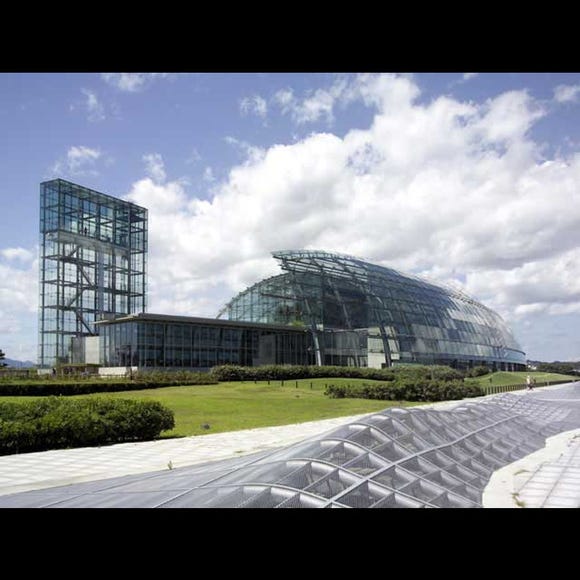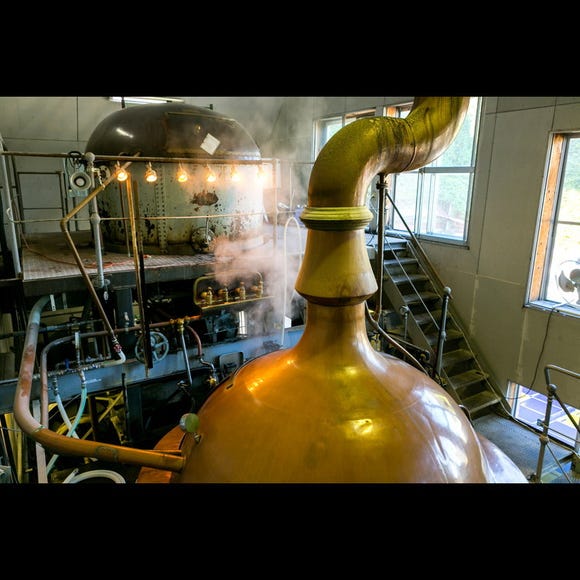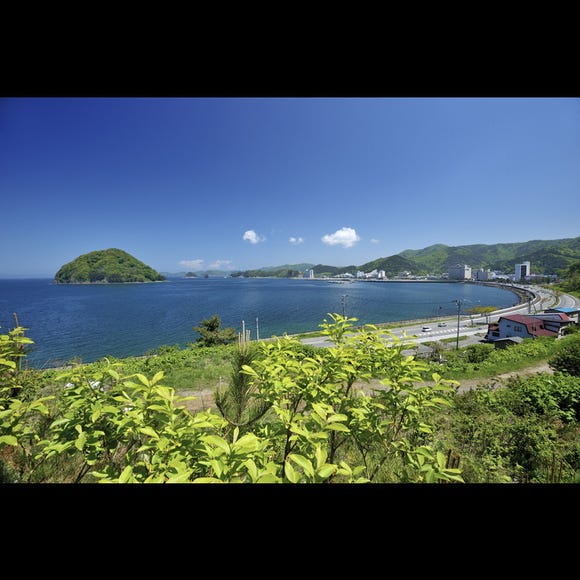
On the sightseeing train Echigo Tokimeki Resort Setsugekka, you’ll savor gourmet dishes that showcase the best of Niigata as you glide through stunning coastal and mountain scenery, including the Japan Sea and Mt. Myoko. This unforgettable three-hour journey lets you take in every breathtaking view through oversized windows—without ever missing a bite.
All Aboard the Echigo Tokimeki Resort Setsugekka!
Sightseeing trains with stylish designs and gourmet dining have become increasingly popular for offering a deeper appreciation of local regions. The Echigo Tokimeki Resort Setsugekka—known simply as Setsugekka—is one such train, serving up Niigata’s finest cuisine as it travels between Joetsu-Myoko and Itoigawa through the scenic Myoko Highlands, with sweeping views of the Japan Sea and Mt. Myoko framed by Japan’s largest train windows.

Two special trains operate only on Saturdays, Sundays, and holidays—one in the morning and one in the afternoon. The morning train departs Joetsu Myoko Station for Itoigawa Station (serving French cuisine), while the afternoon train runs the reverse route with Japanese cuisine on board.
While a Shinkansen covers this journey in just 15 minutes, the Setsugekka takes a scenic three hours, offering a slower, more luxurious ride. The fare is a flat 24,800 yen (including meal and tax; see details below).
This price also gives you unlimited rides on local and rapid Echigo Tokimeki Railway trains for the day. In this article, we’ll share the elegant French meal and memorable journey we enjoyed on the morning departure from Joetsu Myoko Station.
A Luxurious Space Crafted Entirely in Niigata
Reservations and advance payment are required to ride the Setsugekka. You can book by phone, and once payment is confirmed, a “boarding pass” will be sent to you.

To reach Joetsu-myoko Station, the starting point, it takes about 1 hour and 50 minutes from Tokyo via the Hokuriku Shinkansen, or around 2 hours by express train from Niigata Station. After arriving at JR Joetsu-myoko Station, walk through the station to the ticket gate for the Echigo Tokimeki Railway.

Show your boarding pass to the attendant and then proceed to the train platform. The Setsugekka arrived while I was waiting on the platform.

The concept behind the Setsugekka is “all made in Niigata,” with both the carriage interior and cuisine crafted using carefully selected materials from Niigata Prefecture.
The train was designed by architect and designer Yasuyuki Kawanishi, a highly acclaimed creator who has won numerous national and international awards—including one for the Setsugekka—and holds the world’s top honor in railway design.

The gold-colored sections on the front of the carriage are made with Tsubame-Sanjo metal, and the bodies were built by Niigata Transys at their local plant. The expansive windows, stretching nearly to the ceiling, are the largest of their kind on most sightseeing trains and offer a truly immersive travel experience.
Above all, the carriage’s glossy finish is stunning—unsurprising given that the Setsugekka was newly built for its 2016 debut. A three-hour ride aboard this elegant train promises a truly luxurious journey.

I rode in the first car of the two-car train, taking in the spectacular scenery through the 2.3-meter-high windows. The lounge-style seating faces the Sea of Japan on one side and the Myoko Mountains on the other, offering uninterrupted views of both coast and peaks.

The interior of Car No. 1 is inspired by the golden countryside landscape, creating a bright and warm atmosphere. It features Echigo cedar, known for its vivid grain and natural beauty.
Even the smallest details are thoughtfully crafted—the curtain clasps are shaped like mountains and waves, reflecting the scenery seen from the train. The Setsugekka is an impressive sightseeing train, with meticulous care given to areas most travelers might overlook.

Car No. 2 features natural beech wood from Niigata Prefecture and has a chic, refined restaurant-car design. The seats are angled 3 degrees toward the windows for better views while dining and are even more spacious and relaxing than Gran Class seats on the Shinkansen.

The High-Deck observation area at the front of Car No. 2 offers a clear view over the driver’s compartment and the passing scenery. For an additional 15,000 yen (tax included, for 2–4 people), you can reserve this luxurious private space—making your three-hour journey even more memorable.


The Sakura Lounge café and bar in Car No. 2 features walls made of natural Japanese bird cherry wood and a counter crafted from natural cherry wood. The cherry-colored copper cherry blossom patterns on the bar’s side were created by Tsubame-Sanjo artisans, renowned for their metalwork—an elegant touch that left a lasting impression.

In line with its “all made in Niigata” concept, the Setsugekka was built using materials produced in the region. Initially, there were concerns about using real wood due to challenges like the train’s constant motion, humidity shifts, and temperature extremes.
However, through repeated trial and error, the team succeeded in creating a refined space that preserves the warmth and texture of locally sourced wood—resulting in the Setsugekka’s exceptional interior.
Your Scenic Journey Through Japan Begins
A booklet and menu were waiting on a luncheon mat when I sat down.

The Setsugekka makes stops at Nihongi Station, Myokokogen Station, and Noetsu Station before arriving at its final destination, Itoigawa Station. At each stop, passengers can browse and buy local specialties and souvenirs.
As we approached Nihongi Station, the first announcement came on, introducing the scenic views ahead along with background stories about each one. The train started on flat ground but gradually climbed, eventually reaching a steep incline—prompting me to head to the High-Deck observation area in Car No. 1.

All passengers are welcome to use the observation deck in Car No. 1. It's best to head there before reaching Nihongi Station, as this spot offers the best view of the switchbacks the train makes as it climbs.

As the Setsugekka climbs the steep inclines, it first passes the station and then uses a switchback to reverse into the Nihongi Station platform. With two drivers and a conductor monitoring the rear and communicating progress, one of the drivers carefully backs the train in—a fascinating sight to watch up close.
Upon arrival at Nihongi Station, we were warmly welcomed. One of the joys of traveling on the Setsugekka is meeting locals at each stop along the way.


Endless Mountain Views Unfold Before Your Eyes
We boarded the train once more and continued on toward Myokokogen Station. As the journey resumed, a series of breathtaking views unfolded outside the windows.
Not long after departure, we were served a welcome drink to enjoy with the scenery.

The welcome drink was a sparkling wine made especially for the Setsugekka by Fermier Winery in Niigata City. It has a clean, refreshing bouquet with a subtle, elegant, and fruity flavor.
For those who prefer a non-alcoholic option, cider and apple juice are also available.

The first scenic highlight—the Mt. Myoko mountain range—appears while you're enjoying your welcome drink. Mt. Myoko, known as the Joetsu Fuji, stands at 2,454 meters, flanked by Mt. Hiuchi on the right, Mt. Kurohime on the left, and Mt. Iizuna beyond.
With such a sweeping view, it’s easy to lose track of time, completely immersed in the beauty of the landscape.

Due to the steep drop in elevation, the river here flows rapidly, and years of repeated flooding have carved out a U-shaped curve. An announcement explains that it resembles an inverted Omega symbol—a striking reminder of nature’s immense power to shape the land.
About 20 minutes after leaving Nihongi Station, we arrived at Myokokogen Station. The train stops here for around 15 minutes, giving passengers time to step outside with the conductor and browse the Kaneta gift shop just in front of the station.
![▲ Myoko Highlands sit astride the border of Niigata and Nagano prefectures so both Sasa dango [rice cakes wrapped with bamboo leaves] and Oyaki [a flour dumpling stuffed with vegetables seasoned with miso and soy sauce] are sold here.](https://rimage.gnst.jp/livejapan.com/public/article/detail/a/30/00/a3000029/img/en/a3000029_parts_5d43bc7391f65.jpg?20250502134600&q=80)
Echigo Meshi: French-Inspired Cuisine with Local Niigata Flavors
After departing Myokokogen Station, it takes about 40 minutes to reach the next stop, Noetsu Station. This is when the much-anticipated French course lunch is served on the morning train.

The French course is an original menu created by Mr. Iizuka Ryuta, owner-chef of Restaurant Ryuzu in Roppongi, Tokyo, which earned two Michelin stars four years in a row (2015–2018). Originally from Tokamachi City in Niigata Prefecture, he drew on his deep knowledge of local seasonal ingredients to craft this exclusive menu.

The dishes are prepared by Mr. Ishizuka Tsuyoshi, head chef of the long-established Hotel Century Ikaya near Naoetsu Station.
The beautifully arranged appetizers immediately whetted my appetite, so I dove right in. The first box featured a selection of delicate starters.

Cold Beef is a chilled roast beef dish made with Echigo Joetsu Shorthorned Beef, a rare brand raised at Sasagamine Ranch in Myoko City. Grown at an elevation of 1,300 meters with sharp temperature swings between day and night, the beef develops a rich, firm flavor—even in a small portion.

The second box contained the main course of Niigata vegetables prepared in a French style.

The asparagus, potatoes, and daikon radish are all grown in Niigata Prefecture, including the thick, juicy Yaoiro Shiitake from Minami Uonuma City and the Etsu no Maru Eggplant, often called the king of eggplants.
Each vegetable was crisp and subtly sweet. And if you're wondering whether this would be enough for a main course, rest assured—it was thoroughly satisfying.

Finally there is the third box containing sandwiches and baguette.

The sandwiches featured Tsumari Pork, a specialty of Tokamachi City, paired with Kanzuri—a spicy fermented chili paste long made in Myoko City. The mellow richness of the pork and the piquant kick of the Kanzuri perfectly complement each other.
A summer vegetable ratatouille dip, slow-simmered for a smooth, gentle flavor, accompanied the dish. There was also a rich corn soup, with its natural sweetness condensed into a velvety finish.
This is the kind of cuisine you'd expect only at a top-tier French restaurant, all while breathtaking natural scenery rolls by outside the window. The experience felt almost dreamlike.
Just as the meal ends, the train begins to arrive at the third stop: Noetsu Station.
![▲ A station box lunch vendor from Yamazaki-ya, established in 1901, welcomes passengers. Its famous Tara Meshi [cod lunch] took the top prize in the JR East Japan Station Box Lunch Flavor Group 2012 and also appeared on Ekiben Daishogun.](https://rimage.gnst.jp/livejapan.com/public/article/detail/a/30/00/a3000029/img/en/a3000029_parts_5d43bdac84689.jpg?20250502134600&q=80)

Savoring Dessert with Sweeping Views of the Japan Sea
About 40 minutes after leaving Noetsu Station, the train arrives at its final stop, Itoigawa Station. As we near the end of the journey, it’s time to return to my seat and enjoy dessert.
This sweet finale is also the creation of Mr. Iizuka, rounding out the meal with his signature touch.

Yukimuro Coffee is made with beans aged in a yukimuro, a natural snow-cooled storehouse. The result is a sweet, mild flavor with just a hint of bitterness.
You can also choose Yukimuro Coffee Premium Ice Coffee (available in summer) or the Setsugekka Original Snow Lotus Black Tea, a unique blend featuring lotus leaves grown in Takada Park in Joetsu City.

Between Noetsu Station and Itoigawa Station, the train follows a scenic coastal route with sweeping views of the Sea of Japan. This stretch is especially memorable as the train descends from the mountains, passing through several tunnels before reaching the shore.
As the Setsugekka journey neared its end, I made my way to the Sakura Lounge café bar in Car No. 2, which also doubles as a gift shop.

In the Sakura Lounge, you can enjoy locally made wines, draft beer, and soft drinks in a relaxed setting.
Out of 20 local sake brands from breweries in Joetsu, Myoko, and Itoigawa, four are selected each week and offered for tasting.

The soft drink selection includes unique options made exclusively in Niigata, such as Niigata Le Lectier Juice, made from rare Western pears seldom found outside the prefecture. You can also enjoy Tsunan Highlands Carrot Juice and Tsunan Highlands Apple Juice.

The Sakura Lounge also offers a variety of original goods for purchase.
Items include a ring notebook made from Echigo cedar, a unique paper balloon set, and Setsugekka postcards. You can also buy the Yukimuro Coffee and Snow Lotus Black Tea served with dessert—perfect souvenirs to relive the memories of your journey.

Along the route, the train passes Tsutsuishi Station, a well-known stop located entirely inside a tunnel. While the morning train simply passes through, the afternoon train stops to allow passengers a brief tour.
This unusual station is a favorite among railway enthusiasts and draws fans from all over Japan.
A Thoughtful Farewell: Souvenirs to Mark the Journey’s End
Shortly after passing Tsutsuishi Station, the train approaches its final stop.
Before disembarking, passengers receive a parting gift, which varies depending on whether you rode the morning or afternoon train.


After about three hours the trip finally comes to an end when it arrives at Itoigawa Station.
Superb views of Niigata sights such as the Japan Sea, Myoko, and rural scenery; mini tours by the conductor along the way; and meals using plenty of seasonal ingredients from Niigata. This journey that offered so many things ended in the blink of an eye!
I tend to think of trains merely as a means of transportation, so I never imagined one could be so luxurious as this. Just before we pulled in to the terminus I wistfully wished that the trip would not be over. The spectacular views of nature and sumptuous meals provided a brief respite from the fatigue of daily life.
I’m told that passengers ride this train to celebrate wedding anniversaries, birthdays, and even for making marriage proposals. This is the perfect trip for creating special memories. Why not treat yourself to a little luxury sometime and take the Echigo Tokimeki Resort Setsugekka?

- Days of operation
- Saturdays, Sundays, holidays (excluding the end and beginning of the year)
- Route
- Joetsu Myoko Station ~ Itoigawa Station (switchback at Myokokogen Station)
- Departure and Arrival Times
- ・Morning Train: Departs Joetsu-Myoko Station at 10:35 AM, arrives at Itoigawa Station at 1:15 PM
・Afternoon Train: Departs Itoigawa Station at 1:59 PM, arrives at Joetsu-Myoko Station at 4:45 PM
- Fare
- ・Standard Service (Morning/Afternoon) – April to June: 24,800 yen (tax included)
・Summer Service – July to September: 27,800 yen (tax included)
- Reservations
- Call the following number between 10 AM and 5 PM on weekdays: 025-543-8988 (Echigo Tokimeki Resort Setsugekka Reservations Center)
* For more information please check the website.
(Prices in this article are as of May 2025. Note that menu and product availability is subject to change.)
Winter Bonus: Hit the Slopes After the Ride!

You can enjoy a variety of fun snow activities in this area in winter, including skiing and snowboarding. To save money and hassle, we recommend booking lift tickets in advance. Enjoy the unique winter landscapes and outstanding sense of openness that snow resorts afford, while also avoiding the crowds.
- Area
- Category
*Prices and options mentioned are subject to change.
*Unless stated otherwise, all prices include tax.
Popular Tours & Activitiess
Recommended places for you
-

Ginzan Onsen
Hot Springs (Onsen) & Bath Houses (Sento)
Surrounding Areas Of Yamagata
-

Aquamarine Fukushima
Zoos, Aquariums & Botanical Gardens
Fukushima, Koriyama And Iwaki
-

Baeren Brewery Co., Ltd.
Other Sightseeing
Morioka, Hiraizumi And Hachimantai
-

Asamushi Onsen
Hot Springs (Onsen) & Bath Houses (Sento)
Aomori, Hirosaki And Hachinohe
-

Matsushima Bay
Landscapes
Sendai And Matsushima
-

Akiu Onsen
Hot Springs (Onsen) & Bath Houses (Sento)
Sendai And Matsushima
-

Shopping in Akita: 11 Must-Buy Souvenirs & Where to Shop Near the Station and Airport
by: ShiroKu inc.
-

Shopping in Niigata: 9 Must-Buy Souvenirs & Local Sake to Take Home
by: ShiroKu inc.
-

What to Buy in Aomori? 11 Aomori Souvenirs Locals Actually Recommend
by: ShiroKu inc.
-

Aomori's Quiet Side in Autumn: 5 Scenic Spots in Hachinohe According to a Local
by: Marco Blasco
-

Dining in Yamagata: Must-Try Foods & Top Restaurants Near the Station
by: ShiroKu inc.
-
Ad

Just one stop from Haneda Airport! "Truly Japanese!" Food, Fun, and Knowledge Gather at HICityⓇ Enjoy An Electrifying Night at "Japan Night Fever: Haneda Innovation City"
by: Yohei Kato
-

20 Best Things to Do in Fukushima Prefecture (Sightseeing Attractions, Local Foods & Activities)
-

Seafood Bowls and More at the Shiogama Seafood Wholesale Market!
-

Yamagata Prefecture Guide: Destinations, Activities, Travel Advice, Shopping & More
by: Steve Csorgo
-

Iwate Bucket List: 20 Best Things to Do in Iwate Prefecture For Tourists (Attractions, Food, Activities)
-

Kouyou Premium Open Bus Tour: Enjoy Breathtaking Autumn Foliage at Oirase Gorge on this Special Bus Tour!
-

Complete Guide to Buying Japanese Medicine in Japan: Phrases and Vocabulary You Need to Know
















